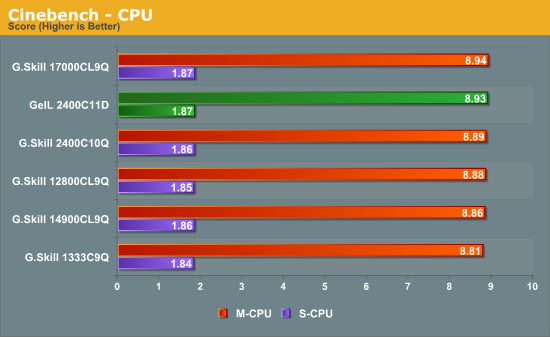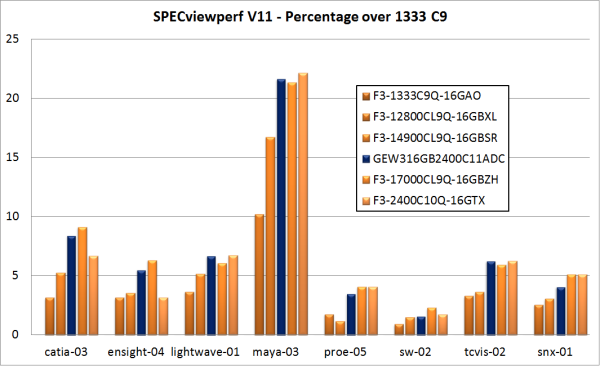GeIL Evo Veloce Review: 2x8GB at DDR3-2400 C11-12-12 1.65 V
by Ian Cutress on October 24, 2012 5:50 PM EST- Posted in
- Memory
- Ivy Bridge
- DDR3
- GeIL
Synthetic testing has a way of elevating what may be a minor difference between hardware into a larger-than-life comparison, despite the effect on the usage of the system being near minimal. There are several benchmarks which straddle the line between synthetic and real world (such as Cinebench and SPECviewperf) which we include here.
SPECviewperf
The mix of real-world and synthetic benchmarks does not get more complex than SPECviewperf – a benchmarking tool designed to test various capabilities in several modern 3D renders. Each of these rendering programs come with their own coding practices, and as such can either be memory bound, CPU bound or GPU bound. In our testing, we use the standard benchmark and report the results for comparison.
In most circumstances the 2x8 GB 2400 C11 kit performs near or better than the 2133 C9 kit (Lightwave, Maya, tcvis). For a lot of these results, MHz is more important than command rate, and in terms of catia, having denser modules also seems to help.
Cinebench x64
A long time favourite of synthetic benchmarkers the world over is the use of Cinebench, software designed to test the real-world application of rendering software via the CPU or GPU. In this circumstance we test the CPU single core and multi-core performance, as well as the GPU performance using a single GTX 580 at x16 PCIe 2.0 bandwidth. Any serial factors have to be processed through the CPU, and as such any memory access will either slow or speed up the benchmark.


Not much differentiates any of the memory kits - the main difference is using a GTX 580 for the OpenGL test interestingly enough.











30 Comments
View All Comments
mmstick - Saturday, October 27, 2012 - link
Actually, yes you can tell the difference depending on the applications you run. In fact, the distributed OpenCL GPU computing projects I use over at BOINC, the biological research, requires extreme frequencies. The higher the processor frequency, the higher your GPU load and ability to install more GPUs for the project becomes. If I run my RAM at 1333Mhz with my 7950, I need to run 8 work units in order to get that memory to get 80% efficiency. After overclocking my RAM to 1800Mhz I was able to get the efficiency up to 95%. With faster memory, I could run less work units, and install a second graphics cards, although I would likely need 2133Mhz quad channel memory in order to saturate two 7950s in the HCC project. In POEM, I would actually need 4266Mhz quad channel DDR3 in order to saturate a single 7950 more than likely.Another scenario is AMD APUs, where FPS almost scales linearly based on RAM frequency because it uses system RAM as VRAM. GPUs are very memory intense, which is why GPUs have 256-384 bit memory interfaces. With an APU, the GPU on the die is restricted to the lame 64 bit memory interface we have with our system RAM.
RAM kits like these are sold to people who need them, if you don't need them, buy the lower frequency RAM.
mmstick - Saturday, October 27, 2012 - link
"The higher the processor frequency" I meant "The higher the memory frequency"mmstick - Saturday, October 27, 2012 - link
"to get that memory to 80%" should be "to get GPU utilization to 80%"Impulses - Thursday, October 25, 2012 - link
What's with the cost analysis of all these high speed $150 kits? Would you actually shell out that amount of money for a run of the mill gaming/enthusiast system when there's a ton of 1600 4x4GB or even 2x8GB kits on Newegg selling for $75-85?I've wishlisted like half a dozen G.Skill kits within that range AND with blue spreaders specifically... If I width the search there's tons more obviously, just hoping one of those goes on sale during Thanksgiving for like $50-60, even tho I'm in no dire need to upgrade from 8GB.
(and yeah, looking at blue purely for aesthetic reasons obviously!)
mmstick - Saturday, October 27, 2012 - link
I would because it would cut my research rate in half. I run OpenCL GPU projects on my systems, where if I had 2400Mhz memory I could output twice as many work units with my graphics cards per day in Help Conquer Cancer.n0x1ous - Thursday, October 25, 2012 - link
Green PCB? Really? YukBlack or Nothing
bigboxes - Thursday, October 25, 2012 - link
Do you ever look at your ram once you install it?JonnyDough - Friday, October 26, 2012 - link
That's how I feel. I used to care about the color of my computer case, etc but I realized that its more about longevity and ease of installation for me. It's nice to go with a color theme, but the extra cost each time I upgrade just isn't worth it. So now that I've matured a bit I've decided on mostly black boxes and hardware as its plentiful and price competitive.saturn85 - Thursday, October 25, 2012 - link
how about adding a folding on cpu benchmark?valnar - Friday, October 26, 2012 - link
Memory companies will continue to put out insanely spec'ed pieces so they get reviewed by Hardware sites, because it's the only way to get their name out there. Otherwise, memory as a whole is a pretty boring component. Why else do they also need to have interesting names and brightly colored heatsinks? Marketing at its best (or is it worst?)